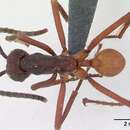en
names in breadcrumbs


Extant: 6 valid subspecies
Formica vagans Olivier, 1792: 501 (w.) FRENCH GUIANA. Neotropic. AntCat AntWikiTaxonomic history
Smith, 1855c PDF: 162 (s.); Wheeler, 1912f PDF: 206 (m.); Menozzi, 1931d PDF: 188 (q.); Wheeler & Wheeler, 1974c PDF: 170 (l.).Combination in Eciton: Smith, 1855c PDF: 162.Combination in Eciton (Eciton): Emery, 1910b PDF: 21.Status as species: Latreille, 1802a PDF: 243; Smith, 1855c PDF: 162; Smith, 1858a PDF: 151; Mayr, 1863a PDF: 409; Roger, 1863b PDF: 36; Mayr, 1886b PDF: 118 (in key); Emery, 1890b PDF: 55; Emery, 1890c PDF: 38; Dalla Torre, 1893 PDF: 6; Emery, 1894d PDF: 178; Emery, 1894l PDF: 45; Forel, 1895b PDF: 121; Emery, 1896h PDF: 625; Forel, 1899b PDF: 24; Forel, 1899j: 273; Wheeler, 1907b PDF: 271; Forel, 1908a PDF: 64; Forel, 1909a PDF: 246; Emery, 1910b PDF: 21; Forel, 1912d PDF: 42; Mann, 1916 PDF: 420; Luederwaldt, 1918 PDF: 37; Santschi, 1920d PDF: 363; Borgmeier, 1923: 40; Santschi, 1923g PDF: 1259; Menozzi, 1931d PDF: 188; Borgmeier, 1934 PDF: 93; Eidmann, 1936a PDF: 28; Borgmeier, 1939 PDF: 405; Borgmeier, 1948b PDF: 459; Borgmeier, 1953 PDF: 13; Borgmeier, 1955 PDF: 229 (redescription); Kempf, 1961b PDF: 486; Kempf, 1970c PDF: 323; Kempf, 1972b PDF: 103; Watkins, 1976 PDF: 9 (in key); Watkins, 1982 PDF: 209 (in key); Wheeler & Wheeler, 1984a PDF: 270; Bolton, 1995b: 186; Palacio, 1999: 151 (in key); Wild, 2007b PDF: 25; Branstetter & Sáenz, 2012 PDF: 254; Palacio, 2019 PDF: 601.Senior synonym of Eciton integrum: Borgmeier, 1953 PDF: 13; Borgmeier, 1955 PDF: 229; Kempf, 1972b PDF: 103; Bolton, 1995b: 186.Senior synonym of Eciton simillima: Smith, 1858a PDF: 151; Mayr, 1863a PDF: 409; Roger, 1863b PDF: 36; Dalla Torre, 1893 PDF: 6; Forel, 1895b PDF: 121; Forel, 1899b PDF: 24; Emery, 1910b PDF: 21; Borgmeier, 1923: 40; Borgmeier, 1953 PDF: 16; Borgmeier, 1955 PDF: 229; Kempf, 1972b PDF: 103; Bolton, 1995b: 186.Central, Paraguarí , “ Paraná R.” (Dept. unknown) (ALWC, INBP, LACM, MCZC). Literature records: “Paraguay” (s. loc.) (Borgmeier 1955, Emery 1896b, Santschi 1920a).
Synonymos: E. francanum v . Jher.; E. angustatum st. reichenspergeri Sants . 1924.
Examinei material de Costa Rica, Guyana Hollandeza, Pernambuco (Tapera), Minas Geraes, Matto Grosso ( Poconé ), Goyaz (Campinas), Rio de Janeiro, Argentina (Loreto).
Os ganchos mandibulares de alguns soldados de Costa Rica apresentam denticulos ou excrescências , que não passam porém de variações individuaes, visto que outros soldados da mesma colónianão apresentam taes caracteres. Já Santschi chamou a attenção para taes variações , sem denominalas(1923, Rev. Mus. Paul. 13, p. 8): «Les mandibules des soldats sont variables, une dent apparait parfois au milieu de leur bord interne».
O macho foi descripto por Wheeler (1921, Psyche, vol. 19, p. 207) sobre material de Costa Rica, o que passou despercebido a Menozzi que escreve (1931): «Non é noto il maschio». A fêmea foi descripta por Menozzi (1931), igualmente sobre material de Costa Rica. Pude examinar uma fêmea da collecção do Serviço da Defesa Sanitária Vegetal (Rio de Janeiro), proveniente de Sta. Cruz, Districto Federal, € encontrada no ninho estabelecido em panellas abandonadas de Atta ; este exemplar concorda em tudo com a descripção e figura de Menozzi.
Santschi considera francanum v. Jher. como variedade de vagans . Em 1934, elle diz (Rev. Soc. Ent. Arg. 6, p. 24): «Cette variété est facile à distinguer du type par son post-pétiole aussi large que long (plus long que large chez le type) et par la couleur souvent plus claire.» Possuo um cotypo de Franca, S. Paulo (Garbe leg., Mus. Paulista No. 15758), cujo postpeciolo é ligeiramente mais comprido que largo. Penso portanto que francanumé synonymo de vagans .
Eciton (Holopone) angustatum st. reichenspergeri Santschi (1924, p. 12) foi descripto de Minas e é segundo communicacao do Dr. Santschi «une variété obscure de vagans . Possuo alguns exemplares cotypos, os quaes têm a cabeça e o thorax quasi pretos; mas tal variação se encontra em indivíduos da mesma colónia .
Formica vagans, Oliv. Encycl. Meth. vi. 501.
Eciton vagans, Smith , Trans. Ent. Soc. Lond. iii. new ser. (worker major).
Eciton simillima, Smith , Trans. Ent. Soc. Lond. iii. new ser. (worker minor).
Hab. Brazil; Mexico.
The E. vagans and E. crassicornis have been received from the same locality, and both are entirely of a reddish-brown colour, including the mandibles and legs; there can be little doubt of their belonging to the same species; in general form they resemble E. hamata , the large worker having similar elongated curved mandibles.
Eciton vagans is a species of New World army ant in the genus Eciton. It occurs in dry and wet forest habitats, occupying a range extending from Mexico to throughout Costa Rica and possibly Panama and Colombia. Raids are always in columns and are distinguished in being usually nocturnal; preferred prey commonly include other ants.[2] It is closely related to the Eciton burchellii species.
Eciton vagans is a species of New World army ant in the genus Eciton. It occurs in dry and wet forest habitats, occupying a range extending from Mexico to throughout Costa Rica and possibly Panama and Colombia. Raids are always in columns and are distinguished in being usually nocturnal; preferred prey commonly include other ants. It is closely related to the Eciton burchellii species.